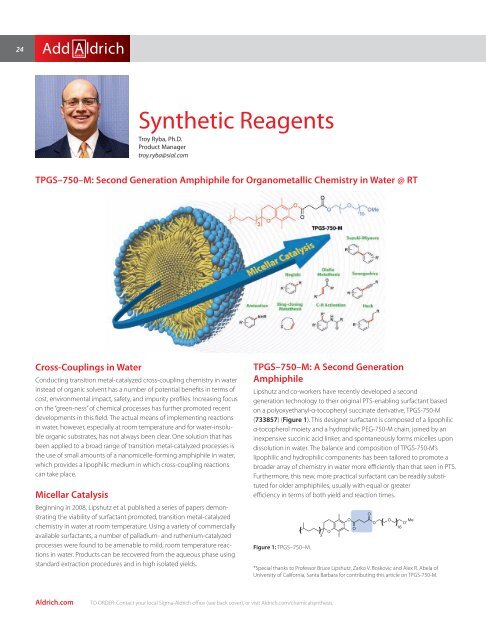Missing out on the latest research developments in ... - Sigma-Aldrich
Missing out on the latest research developments in ... - Sigma-Aldrich
Missing out on the latest research developments in ... - Sigma-Aldrich
Create successful ePaper yourself
Turn your PDF publications into a flip-book with our unique Google optimized e-Paper software.
24<br />
Cross-Coupl<strong>in</strong>gs <strong>in</strong> Water<br />
C<strong>on</strong>duct<strong>in</strong>g transiti<strong>on</strong> metal-catalyzed cross-coupl<strong>in</strong>g chemistry <strong>in</strong> water<br />
<strong>in</strong>stead of organic solvent has a number of potential benefi ts <strong>in</strong> terms of<br />
cost, envir<strong>on</strong>mental impact, safety, and impurity profi les. Increas<strong>in</strong>g focus<br />
<strong>on</strong> <strong>the</strong> “green-ness” of chemical processes has fur<strong>the</strong>r promoted recent<br />
<strong>developments</strong> <strong>in</strong> this fi eld. The actual means of implement<strong>in</strong>g reacti<strong>on</strong>s<br />
<strong>in</strong> water, however, especially at room temperature and for water-<strong>in</strong>soluble<br />
organic substrates, has not always been clear. One soluti<strong>on</strong> that has<br />
been applied to a broad range of transiti<strong>on</strong> metal-catalyzed processes is<br />
<strong>the</strong> use of small amounts of a nanomicelle-form<strong>in</strong>g amphiphile <strong>in</strong> water,<br />
which provides a lipophilic medium <strong>in</strong> which cross-coupl<strong>in</strong>g reacti<strong>on</strong>s<br />
can take place.<br />
Micellar Catalysis<br />
<strong>Aldrich</strong>.com<br />
Syn<strong>the</strong>tic Reagents<br />
Troy Ryba, Ph.D.<br />
Product Manager<br />
troy.ryba@sial.com<br />
TPGS–750–M: Sec<strong>on</strong>d Generati<strong>on</strong> Amphiphile for Organometallic Chemistry <strong>in</strong> Water @ RT<br />
Beg<strong>in</strong>n<strong>in</strong>g <strong>in</strong> 2008, Lipshutz et al. published a series of papers dem<strong>on</strong>strat<strong>in</strong>g<br />
<strong>the</strong> viability of surfactant promoted, transiti<strong>on</strong> metal-catalyzed<br />
chemistry <strong>in</strong> water at room temperature. Us<strong>in</strong>g a variety of commercially<br />
available surfactants, a number of palladium- and ru<strong>the</strong>nium-catalyzed<br />
processes were found to be amenable to mild, room temperature reacti<strong>on</strong>s<br />
<strong>in</strong> water. Products can be recovered from <strong>the</strong> aqueous phase us<strong>in</strong>g<br />
standard extracti<strong>on</strong> procedures and <strong>in</strong> high isolated yields.<br />
TPGS–750–M: A Sec<strong>on</strong>d Generati<strong>on</strong><br />
Amphiphile<br />
TO ORDER: C<strong>on</strong>tact your local <strong>Sigma</strong>-<strong>Aldrich</strong> offi ce (see back cover), or visit <strong>Aldrich</strong>.com/chemicalsyn<strong>the</strong>sis.<br />
Lipshutz and co-workers have recently developed a sec<strong>on</strong>d<br />
generati<strong>on</strong> technology to <strong>the</strong>ir orig<strong>in</strong>al PTS-enabl<strong>in</strong>g surfactant based<br />
<strong>on</strong> a polyoxyethanyl-α-tocopheryl succ<strong>in</strong>ate derivative, TPGS-750-M<br />
(733857) (Figure 1). This designer surfactant is composed of a lipophilic<br />
α-tocopherol moiety and a hydrophilic PEG-750-M cha<strong>in</strong>, jo<strong>in</strong>ed by an<br />
<strong>in</strong>expensive succ<strong>in</strong>ic acid l<strong>in</strong>ker, and sp<strong>on</strong>taneously forms micelles up<strong>on</strong><br />
dissoluti<strong>on</strong> <strong>in</strong> water. The balance and compositi<strong>on</strong> of TPGS-750-M’s<br />
lipophilic and hydrophilic comp<strong>on</strong>ents has been tailored to promote a<br />
broader array of chemistry <strong>in</strong> water more effi ciently than that seen <strong>in</strong> PTS.<br />
Fur<strong>the</strong>rmore, this new, more practical surfactant can be readily substituted<br />
for older amphiphiles, usually with equal or greater<br />
effi ciency <strong>in</strong> terms of both yield and reacti<strong>on</strong> times.<br />
Figure 1: TPGS–750–M.<br />
3<br />
O<br />
O<br />
O<br />
O<br />
O<br />
O<br />
O Me<br />
16<br />
*Special thanks to Professor Bruce Lipshutz, Zarko V. Boskovic and Alex R. Abela of<br />
University of California, Santa Barbara for c<strong>on</strong>tribut<strong>in</strong>g this article <strong>on</strong> TPGS-750-M.

















